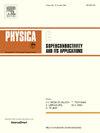Synthesis and characterization of YBCO superconducting thin films doped with BaHfO3 via the TFA-MOD technique for potential aerospace applications
IF 1
3区 物理与天体物理
Q4 PHYSICS, APPLIED
Physica C-superconductivity and Its Applications
Pub Date : 2024-12-17
DOI:10.1016/j.physc.2024.1354633
引用次数: 0
Abstract
The study aims to improve the critical current density (Jc) and flux pinning of YBa2Cu3O7-δ (YBCO) high-temperature superconducting films. The decline in Jc at high temperatures and magnetic fields is due to intrinsic crystalline anisotropy, thermal fluctuations, and lack of effective pinning centers. To tackle this, the study uses a novel approach by incorporating BaHfO3 (BHO) nanostructures (dots, rods, or particles) as artificial pinning centers in YBCO films. The objective is to augment critical current density and enhance flux pinning properties using trifluoroacetates metal organic deposition method (TFA-MOD) on SrTiO3 (STO) substrates, with a specific focus on applications in the aerospace industry. Characterization of YBCO solutions involves measuring contact angle, viscosity, and modulus. Thermal, structural, microstructural and superconducting properties of the films were scrutinized by Differential Thermal Analysis-Thermogravimetry (DTA-TG), Fourier Transform Infrared (FTIR), X-ray diffractometry (XRD), X-Ray Photoelectron Spectroscopy (XPS), Scanning Electron Microscopy-Energy Dispersive Spectroscopy (SEM-EDS) and Atomic Force Microscopy (AFM), Surface Profilometer (SP) and Physical Property Measurement System (PPMS). Rheological tests show viscosity decreases with temperature before stabilizing. Undoped YBCO exhibits good wetting on STO substrates. Heat treatment involves organic solvent removal and TFA decomposition, with FTIR and XRD analyses confirming decomposition of acetate complexes and strong c-axis texture. XPS results indicate consistent chemical compositions, while surface morphologies are flat and crack-free, with denser structures in BHO-doped films. Doping improves superconductivity up to a certain concentration, after which it decreases. Average film thickness is around 240 nm. Undoped YBCO films exhibit poor superconducting properties due to secondary phases, while BHO doping influences superconductivity, with an increase in critical current density up to a certain concentration, beyond which superconductivity is lost.
利用TFA-MOD技术合成和表征掺bafo3的YBCO超导薄膜,具有潜在的航空航天应用前景
这项研究旨在提高 YBa2Cu3O7-δ (YBCO) 高温超导薄膜的临界电流密度(Jc)和磁通钉。在高温和磁场条件下,Jc 下降的原因是晶体的固有各向异性、热波动和缺乏有效的钉扎中心。为了解决这个问题,本研究采用了一种新方法,在 YBCO 薄膜中加入 BaHfO3 (BHO) 纳米结构(点、棒或颗粒)作为人工引脚中心。其目的是利用三氟乙酸盐金属有机沉积法 (TFA-MOD) 在氧化钛酸锶 (STO) 基底上提高临界电流密度并增强磁通引脚特性,特别关注航空航天工业中的应用。YBCO 溶液的表征包括测量接触角、粘度和模量。通过差热分析-热重分析法(DTA-TG)、傅立叶变换红外光谱法(FTIR)、X 射线衍射仪(XRD)、X 射线光电子能谱仪(XPS)、扫描电子显微镜-能量色散能谱仪(SEM-EDS)、原子力显微镜(AFM)、表面轮廓仪(SP)和物理性能测量系统(PPMS)对薄膜的热、结构、微观结构和超导特性进行了仔细研究。流变测试表明,粘度在稳定之前会随温度的升高而降低。未掺杂的 YBCO 在 STO 基底上表现出良好的润湿性。热处理包括有机溶剂去除和反式脂肪酸分解,傅立叶变换红外光谱和 XRD 分析证实了醋酸盐复合物的分解和强烈的 c 轴纹理。XPS 结果表明化学成分一致,表面形态平整无裂纹,掺杂 BHO 的薄膜结构更致密。掺杂能提高超导性,但掺杂浓度达到一定程度后,超导性就会降低。平均薄膜厚度约为 240 纳米。未掺杂的 YBCO 薄膜由于存在次生相而表现出很差的超导特性,而掺杂 BHO 则会影响超导性,在达到一定浓度时临界电流密度会增加,超过该浓度后超导性就会丧失。
本文章由计算机程序翻译,如有差异,请以英文原文为准。
求助全文
约1分钟内获得全文
求助全文
来源期刊
CiteScore
2.70
自引率
11.80%
发文量
102
审稿时长
66 days
期刊介绍:
Physica C (Superconductivity and its Applications) publishes peer-reviewed papers on novel developments in the field of superconductivity. Topics include discovery of new superconducting materials and elucidation of their mechanisms, physics of vortex matter, enhancement of critical properties of superconductors, identification of novel properties and processing methods that improve their performance and promote new routes to applications of superconductivity.
The main goal of the journal is to publish:
1. Papers that substantially increase the understanding of the fundamental aspects and mechanisms of superconductivity and vortex matter through theoretical and experimental methods.
2. Papers that report on novel physical properties and processing of materials that substantially enhance their critical performance.
3. Papers that promote new or improved routes to applications of superconductivity and/or superconducting materials, and proof-of-concept novel proto-type superconducting devices.
The editors of the journal will select papers that are well written and based on thorough research that provide truly novel insights.

 求助内容:
求助内容: 应助结果提醒方式:
应助结果提醒方式:


